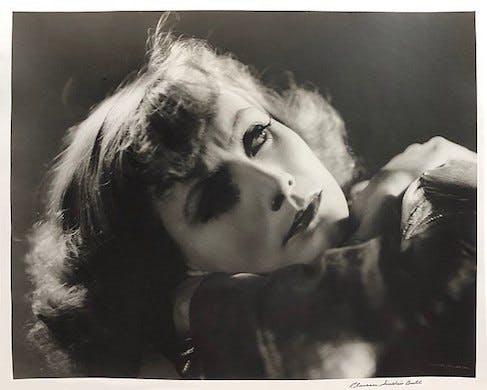Greta Garbo and Beauty by the Book
The biography adds ‘context,’ a superb historical and sociological discussion of how and why Garbo did not fit Hollywood standards of beauty and then became the Hollywood standard of beauty.

‘Ideal Beauty: The Life and Times of Greta Garbo’
By Lois W. Banner
Rutgers University Press, 286 pages
By 1933, it seemed almost universally acknowledged that Greta Garbo was the most beautiful woman in the world. Perhaps only L.B. Mayer, co-founder of MGM, and the Swedish-born actress — then approaching the age of 30 — would have been surprised.
When Garbo arrived at Hollywood in the mid-1920s, she had slimmed down, losing as much as 20 pounds, because Mayer and other producers considered her too fat. They also thought that at 5 feet, 7 inches, she was too tall. The ideal height for female stars was somewhere between 5 feet flat (Mary Pickford size) up to maybe 5 feet 3.
Ideas of beauty, though, caught up to Garbo, with the assistance of cinematographers, fashion designers, fan magazines, and Garbo herself, who did not hew to Hollywood dictates and cross-dressed — even though she provoked yet more criticism for so-called mannish behavior and attire.
Lois Banner has assessed all the Garbo biographies (see her meticulous notes), including those in Swedish, a language she learned during her research, and provides many new insights into Garbo’s life and corrects errors in English-language biographies.
Ms. Banner is the foremost historian of beauty, publishing “American Beauty” in 1983 and “Marilyn: The Passion and the Paradox” in 2012. Ms. Banner adds to Garbo’s biography what she calls “context,” a superb historical and sociological discussion of how and why Garbo did not fit Hollywood standards of beauty and then became the Hollywood standard of beauty.
To those who do not know the history of Garbo biography and the varying reception of her acting and her persona, the remarkable range of negative comments — especially from American critics — on both her appearance and her performances may be startling. In Europe, she had a higher reputation, though, as Ms. Banner documents, the actress was more bothered in Sweden by the press and fans than was the case in America.
For Ms. Banner, Garbo’s signature role is Queen Christina, a character admired as a feminist heroine whom Garbo resembled in many respects, though the royal personage had a hook nose and was no nowhere near the beauty Garbo personified. Not only did both women exhibit an intense interest in art, literature, and religion, the queen of Sweden and the queen of Hollywood each renounced a powerful position — Christina abdicated at 28 and Garbo relinquished movie stardom before she was 40.
Garbo was severely disappointed that Hollywood did not value her performance in “Queen Christina” (1933) and did not offer her similar roles, which she did not seek out, concluding (wrongly, Ms. Banner argues) that the film was a failure. Louis B. Mayer doctored the books to make it appear as though “Queen Christina” lost money. To Ms. Banner, the film is a triumph that makes Garbo’s retreat from adventurous roles all the more regrettable.
Neither Queen Christina nor Garbo ever married, though Garbo had many male and female consorts who served her in all sorts of capacities as lovers, financial advisors, acting coaches, and, in one case, her barber when she was upset that beauticians began selling stories about her.
Garbo lived to be 84, and yet she suffered from poor health for much of her life. She had various gynecological problems and Ms. Banner believes the evidence strongly suggests the actress suffered from gonorrhea.
At various times during her long retirement from the screen, Garbo considered the kind of comeback the fabled actress Duse managed after a decade away from the stage. Sometimes the financing for the projected films fell through and sometimes Garbo simply retreated, no longer willing to put her aging face on screen or to submit to the rigors of filmmaking that had resulted in physical breakdowns.
All this is not to say that Garbo, like the ballerina in “Grand Hotel,” wanted to be alone. On the contrary, she was quite sociable, with many friends, traveled widely, and had many walking companions at New York City, where she spent much of her later life. Yet she did not want to be photographed, or exhibited at parties, or publicized in any way that might detract from the legend she portrayed in her Hollywood heyday.
Mr. Rollyson is the author of “Female Icons: Marilyn Monroe to Susan Sontag.”

